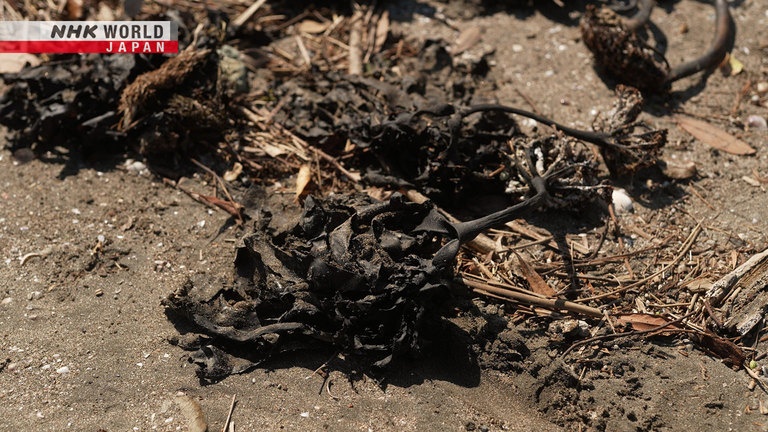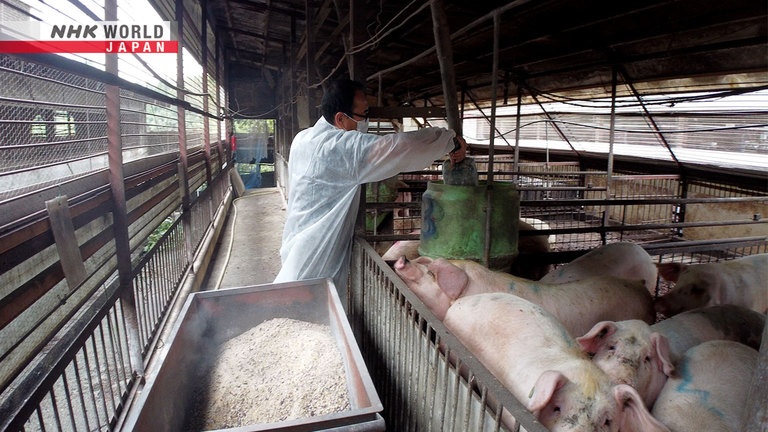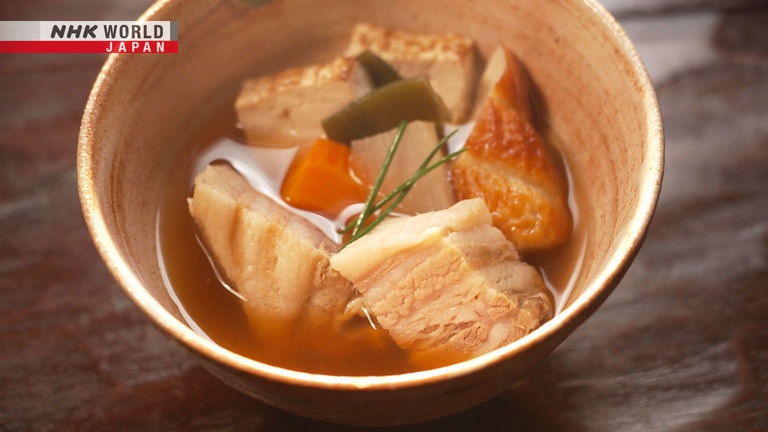Clean Beaches, Cleaner Plates
Kamakura, a beautiful historic seaside town, has a garbage problem: seaweed that starts to smell if it isn't disposed of. Culinary researcher Yano Fukiko has come up with a use for it. She gathers, dries, grinds and feeds it to pigs. The meat produced is tender and rich in umami. What's more, disabled and elderly people living in the area are at the heart of Yano's project. The result of the hard work of many people, Kamakura seaweed pork has been very well received.




Transcript
Since ancient times, the Japanese have believed that a life force resides in all creations.
Valuing and caring for the things we use, a "Zero Waste Life."
Pointing the way to better living for a new era.
The sea itself is alive,
the fish and the seaweed.
Caring for that life
is the responsibility of everyone.
With a clear view of Japan's iconic Mt. Fuji, the historic seaside town of Kamakura.
Born and raised here, culinary researcher, Yano Fukiko.
She's found a way to make use of a certain type of trash that's become a real problem for her hometown.
What exactly is this "trash" that regularly washes up on the local beach?
Here it is, this is it.
Seaweed.
In some parts of Japan, this type of seaweed
is a common ingredient; it's quite nutritious.
I don't want it to go to waste as trash
on the beach, I want to make use of it.
Large quantities of seaweed wash up on Kamakura's beaches.
Left to rot it produces a foul odor, and so is treated as trash.
But Yano was sure she could find a use for it.
Okay, let's get started.
At first she was alone, but now she has helpers.
Individuals with disabilities collect the seaweed through a social participation work program, with permission from the local fishery coop.
I couldn't do it without their help.
It started as a way to help them, but
now they're essential to what I'm doing.
We got a lot today.
Great, right?
This is a good spot.
But what is this seaweed actually used for?
Once it's dried, the pigs can eat it.
Yeah, we give it to the pigs.
Yano's idea: turn this seaweed, otherwise discarded as trash, into feed for pigs, and creating a local brand of Kamakura pork.
Yano's next stop, an elder care facility.
Hello! We've got a load of seaweed.
- Thank you!
- You worked really hard.
We'll take it from here. Thanks.
It's always a pleasure.
Here, they'll wash the salt off of the seaweed, cut it down to an appropriate size, and then hang it up to dry.
Such amazing teamwork!
Right? It's all done in a flash,
but nobody assigns roles really.
It's nice having some work to do
instead of just sitting around.
Everyone does what they can.
Our work is light, but we all have a part.
I think it's great that we can help
to revitalize the local economy.
Once dried, it's cut even finer using scissors and then a blender, so it's ready to become pig feed.
The finished feed is taken straight to the pig farm by Yano herself.
It's important to actually go there.
We mustn't forget how hard it is
for the people doing the real work.
A pig farm about 40km outside central Kamakura.
They insist on using only local feed for raising their special breed of pigs.
Good morning! Thanks for your help.
Pig farmer, Usui Kin-ichi.
Upon hearing about Yano's seaweed pig feed, he immediately decided to use it.
This is great! Having it cut
so fine makes it easy to use.
Each one is 100g, so maybe these are stalks.
I'll put it to use right away.
He initially gave the seaweed feed to his pigs for two months.
And it apparently had a real impact on the quality of the meat.
The secret to delicious umami pork
is something called oleic acid.
There was more oleic acid
in the pigs that ate the seaweed.
The fat also has a lower melting point,
so it literally melts in your mouth.
Deep "umami" and fat that melts almost instantly.
A true revolution in the world of pork.
The project has received high praise from the government for its incorporation of social welfare, livestock farming, and fisheries.
I never expected anything like this.
Without the help of all the elderly
and disabled workers, there would be no Kamakura Pork.
They all work so enthusiastically.
I feel so blessed to have met
everyone involved.
Yano hopes to get as many people as possible to eat Kamakura pork, selling it as a way to give back for public funding that benefited the area.
Growing up along the shores of Kamakura, the idea for her current effort came 10 years ago, when visiting a fishery specializing in "shirasu," a small famous local fish.
There she saw undesirable fish being thrown away.
The anchovies were thrown out,
but it was really a lot of them.
I knew they were popular in Italian food,
so why not in Kamakura cooking too?
Use the anchovies as a processed food, and we don't have to throw them away.
To sell the idea, she went directly to the fishery coop.
Hello!
Hara Minoru was union president at the time.
He found Yano's idea truly eye-opening.
We don't just catch fish,
we also have to sell them.
I saw that we could benefit
from working together.
I couldn't do anything alone.
But this is an issue that we all
need to do something about.
Aiming to find a use for this wasted resource, together with the cooperative, she successfully marketed the formerly unwanted anchovies.
She was named food advisor for the coop.
And on one of her regular trips to the sea, the seaweed was what caught her eye next.
There's a spirit in all living things.
When you eat, you are
taking that into yourself.
Turning nuisance seaweed into valuable food.
One woman's small effort is about to blossom into a giant movement.
If Kamakura Seaweed Pork
makes it onto people's dining tables, they'll be reminded of the sea.
They'll feel the hard work
that went into raising it.
If the people eating it realize this,
that would make me very happy.
Today, Yano again visits the elder care facility.
She plans to serve Kamakura pork to the residents as a token of thanks.
How would they like it served?
Let's find out from the staff.
- Ground meat isn't so popular?
- Well, it's often left over.
Okay, why not stew the pork belly.
That's sure to be a hit.
I want everyone to enjoy it.
Eating the pork they helped produce means expectations are high.
Raising pigs like this, knowing the taste
helps them see the results of their efforts, which is good for the residents.
Now it's time to get cooking.
Most things are one-way,
but sometimes they come back to us.
If the food they eat today makes them
feel good tomorrow, then I'll be happy.
She's decided on a rich thick-cut pork belly soup.
To make it more palatable for the old folks she also adds classic "dashi" ingredients.
Then cubed pork, veggies, and "chikuwa" fish cakes...
Stewed until tender, the pork flavor is infused throughout, making a rich, full-bodied soup.
As soon as you pop the meat in your mouth it melts, spreading the incredible "umami" flavor.
Prepared from the heart, Yano's dish of gratitude is ready to serve.
The residents are eager to start eating.
Time to eat.
Looks delicious!
So tender.
Really? I'm so glad.
It goes so well with the dashi.
I'd never tried it that way. It just melts.
It tastes like real affection.
It's all the effort that people
put into producing it.
It's filled with kindness.
Nobody feels like arguing
after eating a dish like this.
I'm so happy.
I must be the happiest person here.
Everyone's efforts helped
to make my idea a reality.
It really was just trash.
But now it's this feast on our table.
And it happened thanks to all of them.
It's simply wonderful.